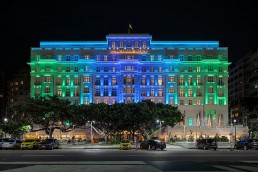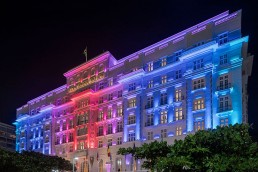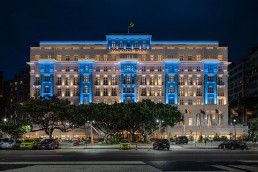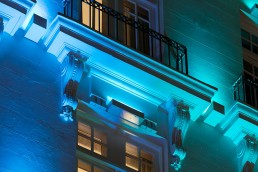This website uses cookies so that we can provide you with the best user experience possible. Cookie information is stored in your browser and performs functions such as recognising you when you return to our website and helping our team to understand which sections of the website you find most interesting and useful.
Copacabana Palace, a Belmond Hotel
ProjectCopacabana Palace, a Belmond HotelLocationRio de Janeiro, BrazilManufacturersPharos Architectural ControlsArchitectTah Arquitetura E ConsultoriaLighting DesignerMonica Luz Lobo, LD Studio, BrazilSubmitted byPharos Architectural Controls
As part of a lighting renovation on the façade of the world-famous Copacabana Palace, a Belmond Hotel, a system from Pharos Architectural Controls is being used for lighting control.
The hotel, which adorns the lively Copacabana beachfront in the Brazilian Capital city of Rio de Janeiro has been a feature of the area since opening in 1923. With a large swimming pool, plush bedrooms and plenty of places to dine and drink, it is no surprise that visitors flock to the Copacabana Palace Hotel to soak up the Brazilian sun and enjoy the area.
Award-winning design and lighting company LD Studio was commissioned to deliver the redevelopment of the façade lighting. The project was led by architect and certified lighting designer Monica Luz Lobo. It was important to the owners of the hotel that the project brought together the tradition of the famed hotspot, with a contemporary feel. Monica has been able to achieve this through her unique vision.
To fulfil the lighting control element of the design, a Designer Lighting Playback Controller (LPC) from Pharos has been specified.
The LPC is controlling a range of architectural linear solutions from LED lighting manufacturer Tryka. The system utilises DMX technology and enables the façade to be changed to different colours, patterns and themes when required, triggered by an iPad touch interface.
The objective of the Copacabana Palace Hotel installation was to rejuvenate the hotel’s iconic façade as part of its centenary celebrations; reducing the famed hotspot’s environmental impact while infusing it with a contemporary feel.
One of the main challenges was the short deadline given for completion. The success of the project relied on all partners working symbiotically, which added pressure on delivering results within the specified timeframe. This required effective project management and coordination among all parties to meet the deadline without compromising on quality. Despite the constraints, the goal was clear: to revive the Copacabana Palace Hotel, preserving its heritage while breathing new life into its exterior.
Another significant challenge was the need to integrate contemporary, energy-efficient LED lighting technology to illuminate the façade while maintaining the traditional charm and heritage of the historic hotel. Balancing the desire for striking visual effects with sustainability considerations posed a challenge that needed to be addressed during the planning and implementation phases.
Monica Luz Lobo, architect and certified lighting designer at LD Studio, had to strike a balance between the hotel’s iconic status and the need for modernisation. Her task was to ensure that the lighting design met the aesthetic and functional requirements of the project. This involved creating dynamic lighting effects that could be adjusted for different occasions, such as international holidays and national events. Monica was able to achieve this by bringing her unique vision to life using a lighting control system from Pharos Architectural Controls. A two universe Designer LPC (Lighting Playback Controller) from Pharos was specified to fulfil the lighting control element of the design.
The LPC controls a range of architectural linear solutions from LED lighting manufacturer Tryka. The system utilises DMX technology and enables the façade to be changed to different colours, patterns and themes when required, triggered by an iPad touch interface.
The project beautifully merges the rich heritage of the Copacabana Palace Hotel with cutting-edge lighting technology. By seamlessly blending tradition with modernity, it preserves the hotel’s historic charm while introducing captivating visual elements.
The innovative design transforms the hotel’s façade into a dynamic canvas, capable of adapting to various occasions and events. The creative vision enhances the hotel’s aesthetic appeal and elevates its status as an iconic landmark in Rio de Janeiro.
By illuminating the façade, the hotel can now be appreciated even during hours of darkness, with its architecture and striking nature being explored through light. To work in harmony with the new lighting, the façade has been restored; and painted in a unique shade of pearly white to showcase its century-old beauty.
Implementing a sophisticated lighting control system required technical expertise and precision. The seamless integration of the Designer LPC from Pharos Architectural Controls showcases a high level of technical proficiency, ensuring optimal performance and functionality. The LPC features individually controllable and independently running timelines and scenes. It offers the freedom of real-time manual overrides, with the versatility of powerful show control and integration features. With a compact form and minimal power requirements, the LPC can be installed anywhere.
By utilising energy-efficient LED lighting, the project aligns with sustainability goals while enhancing the hotel’s nighttime aesthetic. This environmentally conscious approach underscores a commitment to responsible design and operation.
This customisation allows for the hotel to celebrate national days and holidays through a visual display using the façade as the canvas. These include international festivities such as Christmas and New Year and national events including Carnival.
As a must-see destination for visitors to Rio, the glamorous and sophisticated Copacabana Palace Hotel is a star on the Rio skyline, sparkling against the backdrop of the city, representing its history and culture and the Brazilian way of life.








